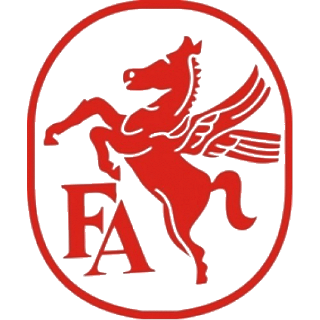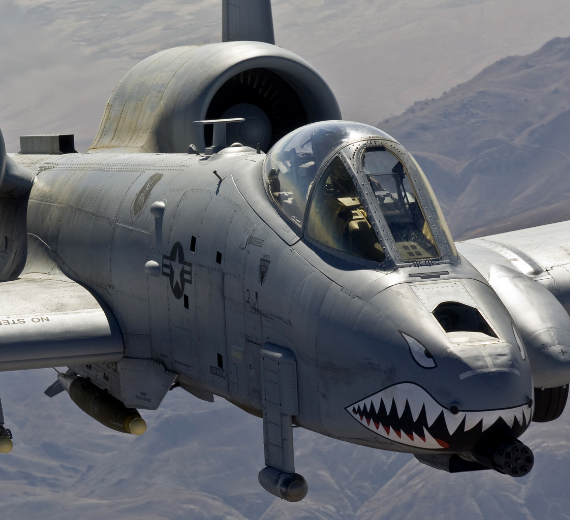.
History Fairchild Aviation Corporation
Fairchild A-10 Thunderbold II "Warthog"

The Fairchild Republic A-10 Thunderbolt II is a single-seat, twin-turbofan, straight-wing, subsonic attack aircraft developed by Fairchild Republic for the United States Air Force (USAF). In service since 1976, it is named for the Republic P-47 Thunderbolt, but is commonly referred to as the "Warthog" or simply "Hog". The A-10 was designed to provide close air support (CAS) to friendly ground troops by attacking armored vehicles, tanks, and other enemy ground forces; it is the only production-built aircraft designed solely for CAS to have served with the U.S. Air Force. Its secondary mission is to direct other aircraft in attacks on ground targets, a role called forward air controller-airborne; aircraft used primarily in this role are designated OA-10.
The A-10 was intended to improve on the performance and firepower of the Douglas A-1 Skyraider. The Thunderbolt II's airframe was designed around the high-power 30 mm GAU-8 Avenger rotary autocannon. The airframe was designed for durability, with measures such as 1,200 pounds (540 kg) of titanium armor to protect the cockpit and aircraft systems, enabling it to absorb damage and continue flying. Its ability to take off and land from relatively short runways permits operation from airstrips close to the front lines, and its simple design enables maintenance with minimal facilities.
It served in the Gulf War (Operation Desert Storm), the American-led intervention against Iraq's invasion of Kuwait, where the aircraft distinguished itself. The A-10 also participated in other conflicts such as in Grenada, the Balkans, Afghanistan, the Iraq War, and against the Islamic State in the Middle East.
Design
Overview

A-10 inboard profile drawing The A-10 has a cantilever low-wing monoplane wing with a wide chord. It has superior maneuverability at low speeds and altitude due to its large wing area, high wing aspect ratio, and large ailerons. The wing also allows short takeoffs and landings, permitting operations from austere forward airfields near front lines. The A-10 can loiter for extended periods and operate under 1,000-foot (300 m) ceilings with 1.5-mile (2.4 km) visibility. It typically flies at a relatively low speed of 300 knots (350 mph; 560 km/h), which makes it a better platform for the ground-attack role than fast fighter-bombers, which often have difficulty targeting small, slow-moving targets.
The leading edge of the wing has a honeycomb structure panel construction, providing strength with minimal weight; similar panels cover the flap shrouds, elevators, rudders and sections of the fins. The skin panels are integral with the stringers and are fabricated using computer-controlled machining, reducing production time and cost. Combat experience has shown that this type of panel is more resistant to damage. The skin is not load-bearing, so damaged skin sections can be easily replaced in the field, with makeshift materials if necessary. The ailerons are at the far ends of the wings for greater rolling moment and have two distinguishing features: The ailerons are larger than is typical, almost 50 percent of the wingspan, providing improved control even at slow speeds; the aileron is also split, making it a deceleron.

Front view of an A-10. Note the 30 mm cannon and offset front landing gear The A-10 is designed to be refueled, rearmed, and serviced with minimal equipment. Its simple design enables maintenance at forward bases with limited facilities. An unusual feature is that many of the aircraft's parts are interchangeable between the left and right sides, including the engines, main landing gear, and vertical stabilizers. The sturdy landing gear, low-pressure tires and large, straight wings allow operation from short rough strips even with a heavy aircraft ordnance load, allowing the aircraft to operate from damaged airbases, flying from taxiways, or even straight roadway sections.
0
KmCeiling
0
KmCombat RANGE
0
Km/hAircraft Speed
0
Max Crew
Photo Gallery
Fairchild Aviation Corporation
Fairchild A-10 Thunderbold II "Warthog"


Fairchild Aviation Corporation.
Fairchild A-10 Thunderbold II "Warthog"
General Info
-
-
- Crew: 1
- Length: 53 ft 4 in (16.26 m)
- Wingspan: 57 ft 6 in (17.53 m)
- Height: 14 ft 8 in (4.47 m)
- Wing area: 506 sq ft (47.0 m2)
-
Powerplant
-
-
- Empty weight: (11,321 kg)
- Gross weight: (13,782 kg)
- CAS mission: (21,361 kg)
- Anti-armor mission: 19,083 kg
- Max takeoff weight: (20,865 kg)
- Fuel capacity: (4,990 kg) internal
- Powerplant: 2 × General Electric TF34-GE-100A turbofans, 9,065 lbf (40.32 kN) thrust each
-
Performance
- Maximum speed: (439 mph, 706 km/h) at sea level, clean
- Cruise speed: (340 mph, 560 km/h)
- Never exceed speed: 450 kn (518 mph, 833 km/h) at 5,000 ft (1,500 m) with 18 Mark 82 bombs
-
Combat range: 250 nmi (463 km)
- Service ceiling: 45,000 ft (13,700 m)
Armament
-
- Guns: 1× 30 mm (1.18 in) GAU-8/A Avenger rotary cannon with 1,174 rounds
- Hardpoints: 11 (8× under-wing and 3× under-fuselage pylon stations) with a capacity of 16,000 lb (7,260 kg),
.
Links to Youtube & Others
Plans to develop a replacement aircraft were announced by the US Air Combat Command in August 2015. In 2016, the USAF began studying future CAS aircraft to succeed the A-10 in low-intensity "permissive conflicts" like counterterrorism and regional stability operations, noting the F-35 to be too expensive to operate in day-to-day roles.
Fairchild A-10 Thunderbold II
The A-10's future remains a subject of debate. In 2007, the USAF expected it to remain in service until 2028 and kater.
Youtube Link
The A-10 was involved in the killing of 35 Afghan civilians from 2010 to 2015













